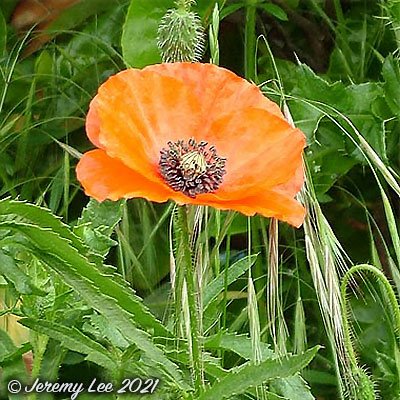
 |
|
Scientific Classifications explained » Amphibians » Ants » Aphids » Bees » Beetles » Birds » Bugs » Butterflies » Caterpillars » Damselflies » Dragonflies » Earwigs » Flies » Frog/Leafhoppers » Fungi » Galls » Grasshoppers » Harvestmen » Hoverflies » Lacewings » Ladybirds » Leaf Mines » Lichens » Mammals » Millipedes » Mosses » Moths » Sawflies » Slugs » Snails » Spiders » Trees & Shrubs » Wasps » Wild Flowers » Woodlice » Postboxes |
UK Nature > Wild Flowers > Red & Pink Wild Flowers > Papaver rhoeas

Common Name: Common Poppy Scientific Name: Papaver rhoeas Papaver rhoeas, more commonly known as Common Poppy, Red Poppy, Corn Poppy or Field Poppy, is a species of flowering plant in the poppy family, Papaveraceae. This poppy, a native of Europe, is notable as an agricultural weed and as a symbol of fallen soldiers. The flower is large and showy, with four petals that are vivid red, most commonly with a black spot at their base. Like many other species of Papaver, it exudes a white latex when the tissues are broken. The leaves and latex have an acrid taste and are mildly poisonous to grazing animals. Papaver rhoeas sometimes is so abundant in agricultural fields that it may be mistaken for a crop. The only species of Papaveraceae grown as a field crop on a large scale is Papaver somniferum, the opium poppy. It is one of only two truly red flowers in this section of the website (the other being Anagallis arvensis, Scarlet Pimpernel); all the others being pink in colour. |
|

https://www.uknature.co.uk is a website dedicated to showing the immense diversity of UK nature and wildlife. Our vast range of habitats, from lowland arable to snow covered mountains, from storm-ravaged coastlines to peaceful inland freshwater lakes and rivers, from dry, sandy heaths to deciduous and coniferous forests, all these habitats contribute to the abundance of UK nature. We have wild birds in huge numbers either residing or visiting our shores (597 recorded species as at July 2013) and we must also not forget the humble back garden with its grass lawns, flower beds filled with nectar rich flowers, shrubs and trees, all designed to attract huge numbers of insects such as bees, moths, butterflies and hoverflies; and finally the small ponds which provide safe havens for frogs, toads, newts and even slow worms and grass snakes. www.uknature.co.uk is the showcase for my personal passion, photographing uknature in all its glory. I sincerely hope you all enjoy the fruits of my labours. This site and all images contained therein is © Jeremy Lee 2004 - 2025. All Rights Reserved. Site design by Jeremy Lee. Site development & IT Support by Stuart Lee. |